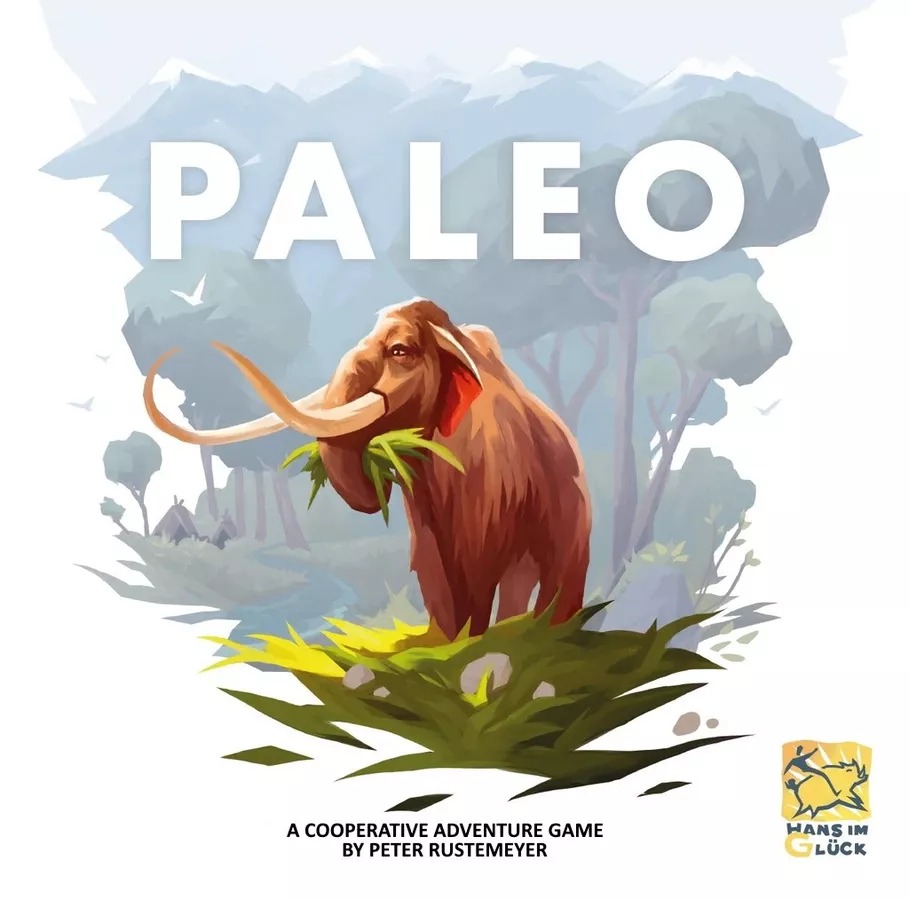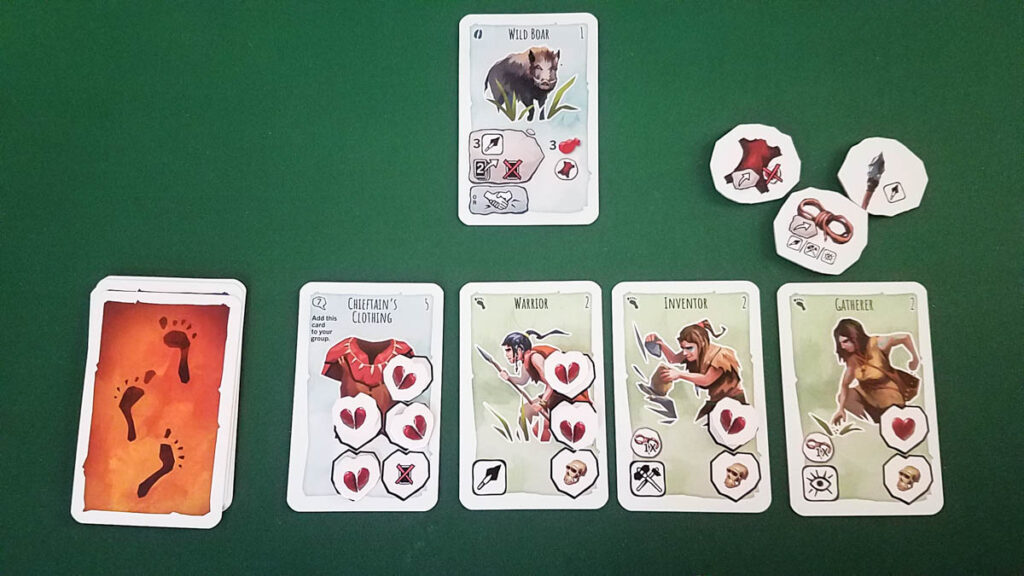Paleo Review
Year: 2020 | Players: 1-4 | Minutes: 45+ | Ages: 10+
This Paleo review was made after playing the game five times (two 3-player games and three 2-player games).
What is Paleo?
Paleo is a cooperative adventure game set in the Stone Age. Your goal in the game is to keep your tribe alive by exploring, finding food, coming up with new technologies, and completing missions.
Paleo was designed by Peter Rustemeyer and is published by Hans im Glück and Z-Man Games.
Rules Overview
Throughout a game of Paleo, you’ll be using actions on cards to get food, find resources, create new tools, recruit people into your tribe, and a bunch of other things. Initially you won’t be able to complete the tougher tasks, but as your tribe grows you’ll be able to work toward getting the victory tokens you need to win the game.
At the start of each game, you’ll choose module decks to face. There are seven pre-made levels that combine two or three of the 10 modules, but you can also create your own. All of the modules are unique, giving you different kinds of tasks and encounters. Most of the module cards are added to the main deck, which is shuffled and dealt out to the players. Each module also has a Mission card that gives you goals to accomplish each round.
Each player starts out with two people in their group, giving them some starting abilities and possibly some starting tools. The main resources (food, wood, and stone) are shared between the players, but each player has their own deck of cards and their own tools.
Rounds have a very straightforward day/night structure. Each turn during the day, everyone simultaneously draws three cards from their decks, looks at the back of those cards, chooses one to reveal, and then performs one of the actions on the chosen card. After everyone has gone through their decks, you have to feed your people and resolve actions shown on the Mission cards (paying resources, etc.). After that, the cards in the discard piles are reshuffled, dealt back out, and you start a new round.
When you draw your three cards, the backs of those cards will give you some idea of what you’re going to be facing, but you can never be sure. For example, you know there’s a pretty good chance that you’ll find some wood and food when you choose a forest card, but you won’t know for sure until you reveal it. The red-backed Hazard cards are pretty much always bad, often leading to one of your people getting injured.
When you reveal your card, there will usually be two or more actions that you can take, including a Help action that allows you to help someone else complete their action. An action’s requirements might include having a certain number of abilities in your group, paying resources, and/or discarding a certain number of cards. When you discard cards to pay for an action, you discard them face-down (this keeps the surprise factor intact); all other discards are placed in the face-up discard pile. If you discard a red-backed card, one of your people has to take a wound. After you pay for an action, you get the rewards shown next to it.
You’ll beat Paleo by collecting five victory tokens, which are gained by resolving certain actions. You’ll lose if you ever get your fifth skull. You get skulls when people in your tribe die, when you can’t feed your people, and when you can’t resolve actions on certain cards, including the Mission cards.
For more info on how the game plays, check out the Paleo rulebook (PDF).
Pros and Cons
Pros
- I love the tension of choosing one of three cards based on its back and then revealing that chosen card. It brings a fun push-your-luck aspect to exploring, which makes sense thematically and makes each turn more interesting than it would be if it was just drawing and revealing a card.
- I prefer co-op games with a lot of cooperation, and Paleo is definitely one of those types of games. You have to constantly communicate with your teammates to increase the chances of everyone being able to do something positive on their turns, like completing a key action or helping someone else complete theirs. There’s also a bit of a co-op memory game going on throughout where everyone tries to remember the types of actions that are on the cards that they saw in past rounds.
- There is an excellent arc to most games of Paleo. You start out weak and try to avoid the tougher tasks, but you learn and you grow as you go and the game usually ends with a close finish.
- There’s very little downtime in this game. It has simultaneous action selection, turns are quick, and the night phase is extremely quick. You’re pretty much always engaged.
- It’s really cool that any cards you use to pay for an action go into a face-down discard pile. That’s especially cool early in the game when you have no idea what those cards are, making exploration that much more exciting.
- It feels great when you’re able to add a new tool to the workbench. Out of nowhere, you have this new ability or a new way to get victory tokens, which gives everyone more fun decisions to make during future turns.
- There’s good replay value here. There are multiple easy, medium, and hard modules, and you can mix them up however you want. I don’t think I’ll play the easiest A + B level ever again, but even those two modules can be mixed with some of the tougher ones to create unique challenges.
- I’m a big fan of the art in this game. The watercolor style looks very nice on the cards and the boards, and Dominik Mayer did a great job making everything look like it belongs in the same world.
Cons
- You can get unlucky with the People cards. If you don’t have a decent-to-good mix of abilities early on, the game is going to be a lot tougher. That’s a bigger problem in two-player games since you only have four people to start with. You could end up with just one or two abilities between you and struggle to get anything done.
- The workbench doesn’t fit in the box fully assembled. That’s not a big deal, but it’s kind of a bummer.
Final Thoughts
Paleo is easily one of my favorite cooperative board games of 2020. I’m a huge fan of co-op adventure games, and this is right up there with the best of them. Its core exploration mechanism is fantastic, there’s plenty of cooperation, and it has a theme that just about everyone can get into. I knew while reading the rulebook that I was going to be a fan of this one, but it’s actually better than I expected.
I think Paleo is a must-have if you usually enjoy playing cooperative games and exploration games.
- Update: Paleo made it onto the Best Co-op Board Games of 2020 list!
- Update 2: It’s also now on our Best Co-op Board Games of All-Time list and our Best Board Games for Two Players list!
- Update 3: It’s also now on the Best Adventure Games list!
Paleo Links
BGG | Amazon | Miniature Market
Thanks for taking the time to read our Paleo review!
Be sure to also take a look at our Best Co-op Board Games list and other rankings.
Subscribe to our newsletter if you want more co-op board game content sent right to your inbox!



